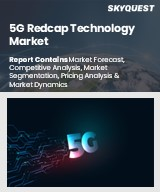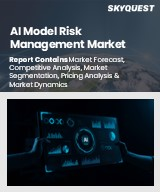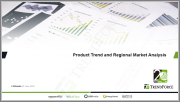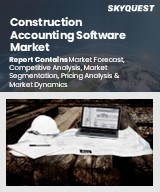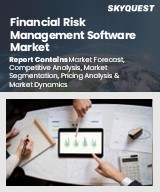
|
시장보고서
상품코드
1722751
원격 가지 소프트웨어 시장 보고서 : 컴포넌트, 전개 모드, 용도, 최종사용자, 지역별(2025-2033년)Remote Sensing Software Market Report by Component (Software, Services), Deployment Mode (On-premises, Cloud-based), Application (Ground, Satellite, Airborne), End User (Defense, Commercial), and Region 2025-2033 |
||||||
세계 원격 감지 소프트웨어 시장 규모는 2024년 21억 달러에 달했습니다. 향후 IMARC Group은 이 시장이 2033년까지 51억 달러에 달하고, 2025-2033년 10.06%의 연평균 성장률(CAGR)을 보일 것으로 예측하고 있습니다. 농업 및 도시 계획에서 정확한 데이터에 대한 수요 증가가 시장을 자극하고 있습니다.
원격 감지 소프트웨어는 원격지에서 수집한 데이터를 분석하기 위한 용도입니다. 사용자 친화적인 인터페이스와 사용하기 쉬운 도구로 구성되어 있으며, 위성 센서의 인텔리전스를 통해 데이터 처리 및 모니터링을 지원하고, 패턴과 추세를 파악하고 유용한 정보를 추출하기 위해 대량의 데이터를 효율적으로 분석할 수 있도록 도와줍니다. 또한 기상 패턴, 수질, 대기오염 등 환경 상태를 실시간으로 모니터링하는 것도 용이해집니다. 원격 센싱 소프트웨어는 On-Premise와 클라우드의 두 가지 도입 모델이 있으며, 전 세계에서 사용할 수 있습니다. 원격센싱 소프트웨어는 자연재해, 자원탐사, 토지이용 매핑 연구에 사용되고 있습니다. 또한 연구자, 과학자 및 기타 전문가들이 환경을 조사하고 자원 관리, 보전 및 기타 활동에 대한 정보에 입각한 의사 결정을 내리는 데 사용됩니다. 또한 재난 대응, 도시 계획, 농업, 임업 등 다양한 용도로 활용되고 있습니다.
원격 감지 소프트웨어 시장 동향 :
원격 감지 기술의 급속한 발전과 환경 위험 관리를 위한 지리정보시스템(GIS) 용도의 채택 확대는 전 세계 시장에 긍정적인 영향을 미치는 주요 요인 중 하나입니다. 또한, 헬스케어, 기상 예측, 과학 연구, 에너지 및 전력, 농업 등 다양한 산업 분야에서 데이터 분석을 위해 원격 감지 소프트웨어가 널리 채택되고 있는 것도 시장 전망을 긍정적으로 만들고 있습니다. 이와는 별도로, 방대한 양의 지리 공간 데이터를 처리하기 위한 지리 영상, 원격 감지, 위성 측위 시스템(GPS) 위성 측량에 대한 수요 증가는 시장 성장을 강화하고 있습니다. 또한, 토지 이용 변화를 모니터링하고, 삼림 벌채를 감지하고, 생태계의 건전성을 평가하기 위한 웹 기반 관리 용도의 급속한 디지털화와 사용 증가는 전 세계적으로 원격 감지 소프트웨어에 대한 수요를 촉진하고 있습니다. 또한, 농업 분야의 급속한 성장과 기후 변화, 작물의 건강 상태, 품질과 관련된 정보를 농부들에게 제공하기 위한 원격 감지 소프트웨어의 사용 확대는 전 세계적으로 사업을 운영하는 주요 시장 기업들에게 유리한 성장 기회를 제공합니다. 또한, 보다 효과적인 채굴 전략을 개발하고 지질학적 과정을 더 잘 이해하기 위해 광상, 단층 및 접곡과 같은 지질학적 특징을 식별하기 위한 원격 감지 소프트웨어의 채택이 증가함에 따라 전 세계 시장 개척에 박차를 가하고 있습니다.
본 보고서에서 다룬 주요 질문
- 2024년 세계 원격 감지 소프트웨어 시장 규모는?
- 2025-2033년 원격 감지 소프트웨어 세계 시장 성장률 전망은?
- 원격 감지 소프트웨어 세계 시장을 이끄는 주요 요인은?
- 코로나19가 원격 감지 소프트웨어 세계 시장 성장에 미치는 영향은?
- 원격 감지 소프트웨어 세계 시장 구성 요소별 분류는?
- 배포 모드에 따른 원격 감지 소프트웨어 세계 시장 현황은?
- 원격 감지 소프트웨어 세계 시장 용도별 분류는?
- 원격 감지 소프트웨어 세계 시장 내 최종 사용자별 시장 현황은?
- 원격 감지 소프트웨어 세계 시장 주요 지역은?
- 세계 원격 감지 소프트웨어 시장의 주요 기업은?
목차
제1장 서문
제2장 조사 범위와 조사 방법
- 조사 목적
- 이해관계자
- 데이터 소스
- 1차 정보
- 2차 정보
- 시장 추정
- 보텀업 접근
- 톱다운 접근
- 조사 방법
제3장 주요 요약
제4장 서론
- 개요
- 주요 업계 동향
제5장 세계의 원격 가지 소프트웨어 시장
- 시장 개요
- 시장 실적
- COVID-19의 영향
- 시장 예측
제6장 시장 분석 : 컴포넌트별
- 소프트웨어
- 서비스
제7장 시장 분석 : 전개 모드별
- On-Premise
- 클라우드 기반
제8장 시장 분석 : 용도별
- 지면
- 위성
- 낙하산
제9장 시장 분석 : 최종사용자별
- 방위
- 상업
제10장 시장 분석 : 지역별
- 북미
- 미국
- 캐나다
- 아시아태평양
- 중국
- 일본
- 인도
- 한국
- 호주
- 인도네시아
- 기타
- 유럽
- 독일
- 프랑스
- 영국
- 이탈리아
- 스페인
- 러시아
- 기타
- 라틴아메리카
- 브라질
- 멕시코
- 기타
- 중동 및 아프리카
- 시장 내역 : 국가별
제11장 SWOT 분석
- 개요
- 강점
- 약점
- 기회
- 위협
제12장 밸류체인 분석
제13장 Porter의 Five Forces 분석
- 개요
- 바이어의 교섭력
- 공급 기업의 교섭력
- 경쟁 정도
- 신규 진출업체의 위협
- 대체품의 위협
제14장 가격 분석
제15장 경쟁 구도
- 시장 구조
- 주요 기업
- 주요 기업 개요
- EOS Data Analytics Inc.
- Esri
- Hexagon AB
- L3Harris Technologies Inc.
- Merrick & Company
- PCI Geomatics
- Textron Systems(Textron Inc.)
- Trimble Inc.
The global remote sensing software market size reached USD 2.1 Billion in 2024. Looking forward, IMARC Group expects the market to reach USD 5.1 Billion by 2033, exhibiting a growth rate (CAGR) of 10.06% during 2025-2033. The growing demand for accurate data in agriculture and urban planning is stimulating the market.
Remote sensing software is an application used for analyzing the data collected from remote locations. It consists of a user-friendly interface and easy-to-use tools that help in processing and monitoring data through satellite sensor intelligence and allowing efficient analysis of large volumes of data for identifying patterns and trends and extracting useful information. It also facilitates real-time monitoring of environmental conditions, such as weather patterns, water quality, and air pollution. Remote sensing software is available in two varying deployment models, including on-premises and cloud across the globe. It is used for studying natural hazards, resource exploration, and land-use mapping. It is also utilized by researchers, scientists, and other professionals to study the environment and make informed decisions about resource management, conservation, and other activities. Moreover, it is employed in a variety of applications, such as disaster response, urban planning, agriculture, and forestry.
Remote Sensing Software Market Trends:
Rapid advancements in remote sensing technologies and the growing adoption of geographic information systems (GIS) applications for environmental risk management represent one of the key factors positively influencing the market across the globe. In addition, the widespread adoption of remote sensing software across numerous industrial verticals, such as healthcare, weather forecasting, scientific research, energy and power, and agriculture, for interpreting data is creating a favorable market outlook. Apart from this, the rising demand for geographic imaging, remote sensing, and global positioning system (GPS) satellite surveying for processing huge volumes of geospatial data is strengthening the market growth. Moreover, rapid digitization and increasing utilization of web-based management applications to monitor changes in land use, detect deforestation, and assess the health of ecosystems are catalyzing the demand for remote sensing software around the world. Additionally, the burgeoning agriculture sector and the increasing utilization of remote sensing software for equipping farmers with information related to climatic variables, crop health, and quality are offering lucrative growth opportunities to key market players operating worldwide. Furthermore, the increasing adoption of remote sensing software to identify mineral deposits and geological features, such as faults and folds, to develop more effective mining strategies and improve the understanding of geological processes is fueling the growth of the market across the globe.
Key Market Segmentation:
Component Insights:
- Software
- Services
Deployment Mode Insights:
- On-premises
- Cloud-based
Application Insights:
- Ground
- Satellite
- Airborne
End User Insights:
- Defense
- Commercial
Regional Insights:
- North America
- United States
- Canada
- Asia-Pacific
- China
- Japan
- India
- South Korea
- Australia
- Indonesia
- Others
- Europe
- Germany
- France
- United Kingdom
- Italy
- Spain
- Russia
- Others
- Latin America
- Brazil
- Mexico
- Others
- Middle East and Africa
- The report has also provided a comprehensive analysis of all the major regional markets, which include North America (the United States and Canada); Asia Pacific (China, Japan, India, South Korea, Australia, Indonesia, and others); Europe (Germany, France, the United Kingdom, Italy, Spain, Russia, and others); Latin America (Brazil, Mexico, and others); and the Middle East and Africa. According to the report, North America (the United States and Canada) was the largest market for remote sensing software. Some of the factors driving the North America remote sensing software market included extensive research and development activities, advancements in remote sensing technologies, increasing adoption of remote sensing software across various industry verticals, etc.
Competitive Landscape:
- The report has also provided a comprehensive analysis of the competitive landscape in the global remote sensing software market. Competitive analysis such as market structure, market share by key players, player positioning, top winning strategies, competitive dashboard, and company evaluation quadrant has been covered in the report. Also, detailed profiles of all major companies have been provided. Some of the companies covered include EOS Data Analytics Inc., Esri, Hexagon AB, L3Harris Technologies Inc., Merrick & Company, PCI Geomatics, Textron Systems (Textron Inc.), Trimble Inc., etc. Kindly note that this only represents a partial list of companies, and the complete list has been provided in the report.
Key Questions Answered in This Report
- 1.What was the size of the global remote sensing software market in 2024?
- 2.What is the expected growth rate of the global remote sensing software market during 2025-2033?
- 3.What are the key factors driving the global remote sensing software market?
- 4.What has been the impact of COVID-19 on the global remote sensing software market growth?
- 5.What is the breakup of the global remote sensing software market based on the component?
- 6.What is the breakup of the global remote sensing software market based on the deployment mode?
- 7.What is the breakup of the global remote sensing software market based on the application?
- 8.What is the breakup of the global remote sensing software market based on the end user?
- 9.What are the key regions in the global remote sensing software market?
- 10.Who are the key players/companies in the global remote sensing software market?
Table of Contents
1 Preface
2 Scope and Methodology
- 2.1 Objectives of the Study
- 2.2 Stakeholders
- 2.3 Data Sources
- 2.3.1 Primary Sources
- 2.3.2 Secondary Sources
- 2.4 Market Estimation
- 2.4.1 Bottom-Up Approach
- 2.4.2 Top-Down Approach
- 2.5 Forecasting Methodology
3 Executive Summary
4 Introduction
- 4.1 Overview
- 4.2 Key Industry Trends
5 Global Remote Sensing Software Market
- 5.1 Market Overview
- 5.2 Market Performance
- 5.3 Impact of COVID-19
- 5.4 Market Forecast
6 Market Breakup by Component
- 6.1 Software
- 6.1.1 Market Trends
- 6.1.2 Market Forecast
- 6.2 Services
- 6.2.1 Market Trends
- 6.2.2 Market Forecast
7 Market Breakup by Deployment Mode
- 7.1 On-premises
- 7.1.1 Market Trends
- 7.1.2 Market Forecast
- 7.2 Cloud-based
- 7.2.1 Market Trends
- 7.2.2 Market Forecast
8 Market Breakup by Application
- 8.1 Ground
- 8.1.1 Market Trends
- 8.1.2 Market Forecast
- 8.2 Satellite
- 8.2.1 Market Trends
- 8.2.2 Market Forecast
- 8.3 Airborne
- 8.3.1 Market Trends
- 8.3.2 Market Forecast
9 Market Breakup by End User
- 9.1 Defense
- 9.1.1 Market Trends
- 9.1.2 Market Forecast
- 9.2 Commercial
- 9.2.1 Market Trends
- 9.2.2 Market Forecast
10 Market Breakup by Region
- 10.1 North America
- 10.1.1 United States
- 10.1.1.1 Market Trends
- 10.1.1.2 Market Forecast
- 10.1.2 Canada
- 10.1.2.1 Market Trends
- 10.1.2.2 Market Forecast
- 10.1.1 United States
- 10.2 Asia-Pacific
- 10.2.1 China
- 10.2.1.1 Market Trends
- 10.2.1.2 Market Forecast
- 10.2.2 Japan
- 10.2.2.1 Market Trends
- 10.2.2.2 Market Forecast
- 10.2.3 India
- 10.2.3.1 Market Trends
- 10.2.3.2 Market Forecast
- 10.2.4 South Korea
- 10.2.4.1 Market Trends
- 10.2.4.2 Market Forecast
- 10.2.5 Australia
- 10.2.5.1 Market Trends
- 10.2.5.2 Market Forecast
- 10.2.6 Indonesia
- 10.2.6.1 Market Trends
- 10.2.6.2 Market Forecast
- 10.2.7 Others
- 10.2.7.1 Market Trends
- 10.2.7.2 Market Forecast
- 10.2.1 China
- 10.3 Europe
- 10.3.1 Germany
- 10.3.1.1 Market Trends
- 10.3.1.2 Market Forecast
- 10.3.2 France
- 10.3.2.1 Market Trends
- 10.3.2.2 Market Forecast
- 10.3.3 United Kingdom
- 10.3.3.1 Market Trends
- 10.3.3.2 Market Forecast
- 10.3.4 Italy
- 10.3.4.1 Market Trends
- 10.3.4.2 Market Forecast
- 10.3.5 Spain
- 10.3.5.1 Market Trends
- 10.3.5.2 Market Forecast
- 10.3.6 Russia
- 10.3.6.1 Market Trends
- 10.3.6.2 Market Forecast
- 10.3.7 Others
- 10.3.7.1 Market Trends
- 10.3.7.2 Market Forecast
- 10.3.1 Germany
- 10.4 Latin America
- 10.4.1 Brazil
- 10.4.1.1 Market Trends
- 10.4.1.2 Market Forecast
- 10.4.2 Mexico
- 10.4.2.1 Market Trends
- 10.4.2.2 Market Forecast
- 10.4.3 Others
- 10.4.3.1 Market Trends
- 10.4.3.2 Market Forecast
- 10.4.1 Brazil
- 10.5 Middle East and Africa
- 10.5.1 Market Trends
- 10.5.2 Market Breakup by Country
- 10.5.3 Market Forecast
11 SWOT Analysis
- 11.1 Overview
- 11.2 Strengths
- 11.3 Weaknesses
- 11.4 Opportunities
- 11.5 Threats
12 Value Chain Analysis
13 Porters Five Forces Analysis
- 13.1 Overview
- 13.2 Bargaining Power of Buyers
- 13.3 Bargaining Power of Suppliers
- 13.4 Degree of Competition
- 13.5 Threat of New Entrants
- 13.6 Threat of Substitutes
14 Price Analysis
15 Competitive Landscape
- 15.1 Market Structure
- 15.2 Key Players
- 15.3 Profiles of Key Players
- 15.3.1 EOS Data Analytics Inc.
- 15.3.1.1 Company Overview
- 15.3.1.2 Product Portfolio
- 15.3.2 Esri
- 15.3.2.1 Company Overview
- 15.3.2.2 Product Portfolio
- 15.3.2.3 SWOT Analysis
- 15.3.3 Hexagon AB
- 15.3.3.1 Company Overview
- 15.3.3.2 Product Portfolio
- 15.3.3.3 Financials
- 15.3.3.4 SWOT Analysis
- 15.3.4 L3Harris Technologies Inc.
- 15.3.4.1 Company Overview
- 15.3.4.2 Product Portfolio
- 15.3.4.3 Financials
- 15.3.5 Merrick & Company
- 15.3.5.1 Company Overview
- 15.3.5.2 Product Portfolio
- 15.3.6 PCI Geomatics
- 15.3.6.1 Company Overview
- 15.3.6.2 Product Portfolio
- 15.3.7 Textron Systems (Textron Inc.)
- 15.3.7.1 Company Overview
- 15.3.7.2 Product Portfolio
- 15.3.8 Trimble Inc.
- 15.3.8.1 Company Overview
- 15.3.8.2 Product Portfolio
- 15.3.8.3 Financials
- 15.3.8.4 SWOT Analysis
- 15.3.1 EOS Data Analytics Inc.






